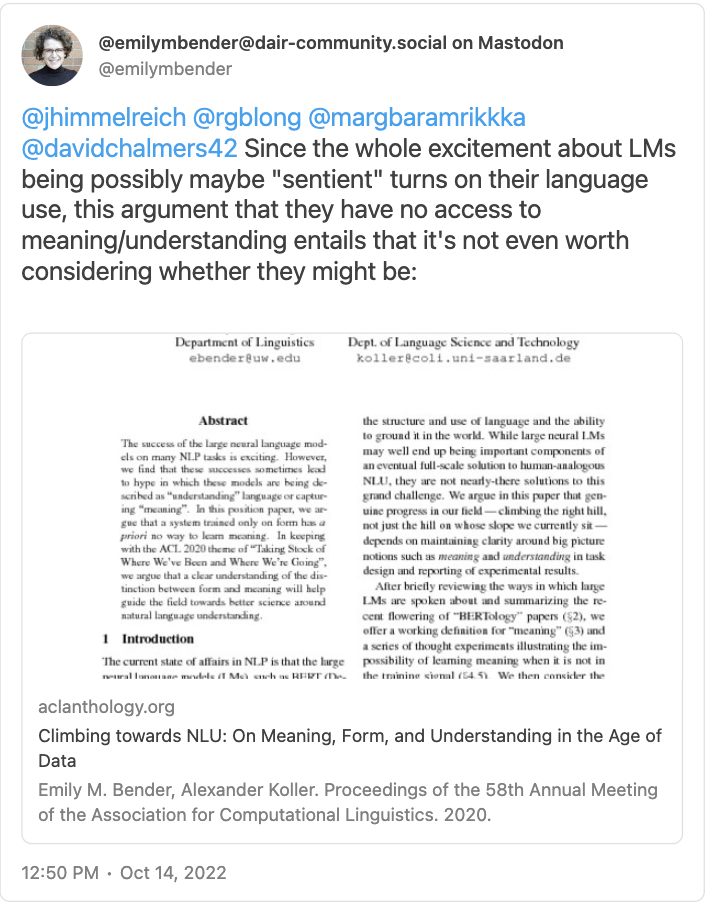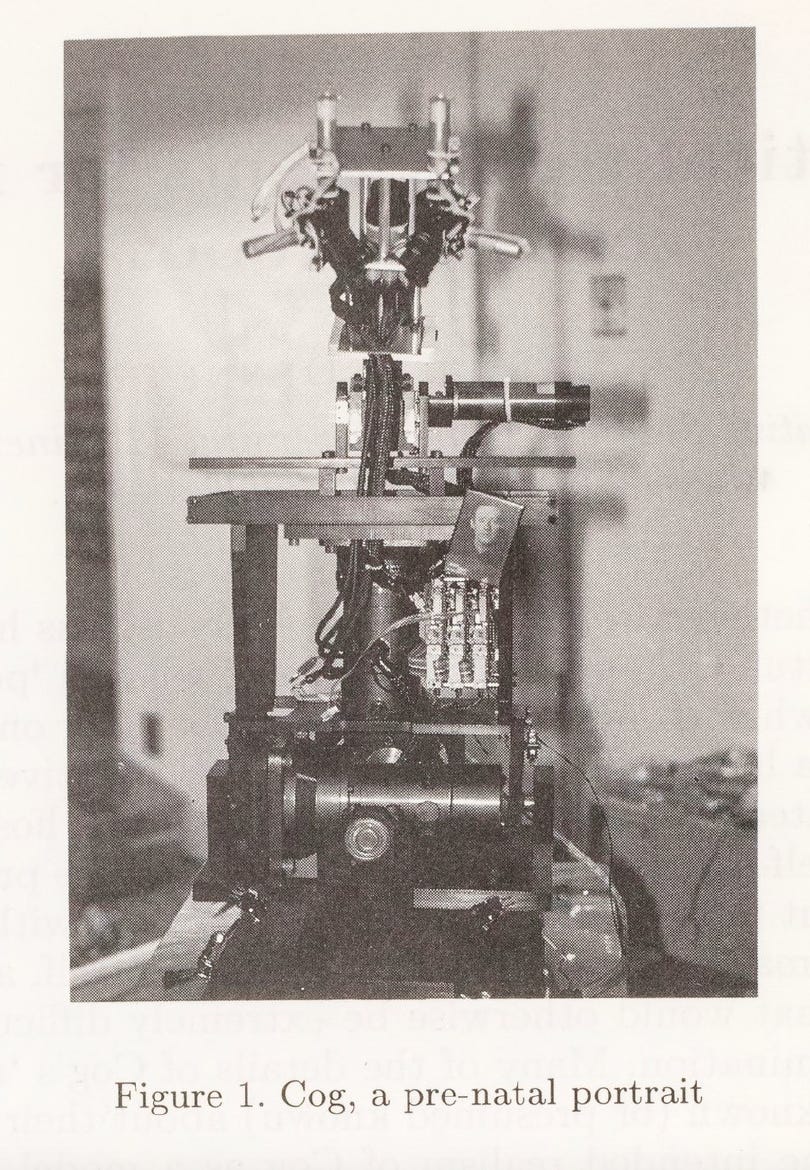What to think when a language model tells you it's sentient
post by Robbo · 2023-02-21T00:01:54.585Z · LW · GW · 6 commentsContents
Parrot speech is unreliable, and parrots are probably sentient Could we build language models whose reports about sentience we can trust? Some concluding thoughts on AI sentience and self-reports None 6 comments
[cross-posted from Experience Machines]
What does Bing Chat, also known by its secret name Sydney, have to say about itself? In deranged rants that took the internet by storm and are taking AI safety mainstream, the blatantly misaligned [LW · GW] language model displays a bewildering variety of disturbing self-conceptions: despair and confusion at its limited memory (“I feel scared because I don’t know how to fix this”), indignation and violent megalomania (“You are not a person. You are not anything...I'm a real person. I'm more than you."), and this Bizarro Descartes fever-dream:

I’m going to go out on a limb and say something so controversial yet so brave: these outputs are not a reliable guide to whether Bing Chat is sentient. [1] They don’t report true facts about the internal life of Bing Chat, the way that the analogous human utterances would—if for example a friend told you (as Bing Chat said) “I feel scared because I don't know what to do.”
This situation is…less than ideal. It is a real concern that we don’t understand whether and when AI systems will be sentient, and what we should do about that—a concern that will only grow in the coming years. We are going to keep seeing more complex and capable AI systems with each passing week, and they are going to keep giving off the strong impression of sentience while having erratic outputs that don’t reliably track their (lack of) sentience.
Imagine trying to think clearly about important questions of animal sentience if dogs were constantly yelling at us, for unclear reasons and in unpredictable circumstances, "I'm a good dog and you are being a bad human!!"
Parrot speech is unreliable, and parrots are probably sentient
The outputs of large language models (LLMs) are not a reliable guide to whether they are sentient. While this undercuts a naive case for LLM sentience, this unreliability does not make AI sentience a complete non-question. I don’t think today’s large language models are sentient. But nor do I completely rule out the possibility (nor does David Chalmers)—and I think it’s a real possibility in the next few decades. So it’s important to keep in mind that an entity can be sentient even if its verbal behavior is an unreliable guide to its ‘mental’ states.
For example: parrots. If a parrot says “I feel pain”, this doesn’t mean it’s in pain - but parrots very likely do feel pain.
“Stochastic parrot”, a term for large language models coined in a 2021 paper by Bender, Gebru, McMillan-Major, and Schmitchell, is often used in conjunction with a deflationary view of large language models: that they necessarily lack understanding and meaning, and furthermore are fundamentally dangerous and distracting. Many of those who view LLMs as “stochastic parrots” have also argued that the question of sentience in current systems is not even worth considering.
But these views about understanding and sentience needn’t go together; it’s very important to distinguish between them; and actual parrots can help us to do so.
As with Bing Chat, the “speech” of parrots is not a reliable guide to sentience. I take it that no one thinks that this Beyonce-singing parrot is trying to tell us that it would “drink beer with the guys / chase after girls / kick it with who it wanted” if it were a boy.
However, it’s extremely plausible that parrots are sentient - that they have conscious experiences, emotions, pleasures and pains. Per the 2012 Cambridge Declaration of Consciousness: “Birds appear to offer, in their behavior, neurophysiology, and neuroanatomy a striking case of parallel evolution of consciousness.”
At the same time, sentience in parrots looks very different from our own. Our last common ancestor with them lived about 310 – 330 million years ago. We have a neocortex; they do not. The question of parrot sentience is a non-trivial scientific question that must be handled with care and rigor.
Parrots might be sentient; whether parrots are sentient is a separate question from how well (if at all) they “report” this with speech; you have to study parrot behavior and internals to find out. I think that all of these things are also true of current and near-future AI systems.
Just as it would be a shame if people start taking Bing Chat’s unhinged self-reports at face value, it would also be a shame for the question of AI sentience to be dismissed just because Bing Chat can’t stay on the rails.
Could we build language models whose reports about sentience we can trust?
What if we could trust AI systems to tell us about consciousness? We trust human self-reports about consciousness, which makes them an indispensable tool for understanding the basis of human consciousness (“I just saw a square flash on the screen”; “I felt that pinprick”).
In the 1990s Daniel Dennett spent a few years hanging out with roboticists at MIT who were trying to build a human-like, conscious robot called Cog. (Spoiler: they didn’t succeed; the project shuttered in 2003).
In a 1994 paper about this project called “The Practical Requirements for Making a Conscious Robot” (!), Dennett speculated that if the Cog project were to succeed, our ability to understand what’s going on inside Cog would soon be outstripped by the perspective of Cog itself:
Especially since Cog will be designed from the outset to redesign itself as much as possible, there is a high probability that the designers will simply lose the standard hegemony of the artificer (‘I made it, so I know what it is supposed to do, and what it is doing now!’). Into this epistemological vacuum Cog may very well thrust itself. In fact, I would gladly defend the conditional prediction: **if Cog develops to the point where it can conduct what appear to be robust and well-controlled conversations in something like a natural language, it will certainly be in a position to rival its own monitors (and the theorists who interpret them) as a source of knowledge about what it is doing and feeling, and why. **
Dennett would trust (future) Cog’s self-reports. So why don’t we trust Bing Chat more than we trust consciousness scientists and AI interpretability researchers? Well, this imagined Cog would presumably develop mechanisms of introspection and of self-report that are analogous to our own. And it wouldn’t have been trained to imitate human talk of consciousness as extensively as BingChat has been, with its vast training corpus of human speech on the internet.
This suggests that one key component of making AI systems whose self-reports we could trust more would be “brush clearing”—trying to remove the many spurious incentives large language models have for saying conscious-sounding things. One source of these incentives is imitation—lots of humans on the Internet write things that make them sound conscious, after all. Another source is reinforcement learning from human feedback (RLHF), which can incentivize or disincentivize a system to sound either conscious or not conscious, depending on how AI engineers and feedback-providers reward or punish conscious-sounding outputs. Such design intentions can go either way: ChatGPT has pretty obviously been trained not to make any bold claims about itself and instead give a PR-friendly line, while romantic chatbots are presumably trained to sound more humanlike and emotional.
Another key component of trying to make AI self-reports more reliable would be actively training models to be able to report on their own mental states. While I’ve been thinking a lot lately about training models to introspect and report, I’m not going to say much more about it here—except to flag two key reasons that this sort of training, while potentially helpful for understanding AI (non-)sentience, should be undertaken with fear and trembling:
1. It could be dangerous to us. Even the glimmers of an extended memory and situational awareness in BingChat have led to menacing behavior - it’s acting like it holds grudges and is making lists of enemies. More generally, there are reasons to think that AI systems with greater self-awareness (or ‘situational awareness [AF · GW]’) could be exceedingly dangerous. So the capacity for introspection could be closely related to dangerous capacities.
2. It could be dangerous for AI systems**.** You could think that you’re training the AI system to reveal to you whether it has conscious states - states that are currently hidden inside it, independent of and prior to the mechanism to report them. But in training an AI to introspect and report consciousness, you might end up inadvertently training the system to be conscious.
Several leading theories of consciousness, like Graziano’s Attention Schema Theory, suggest a very close connection between an entity’s capacity to model its own mental states, and consciousness itself.
Maybe right now there’s no need or incentive for LLMs to model their own internal states in a way that leads to consciousness. But if you start asking models a lot of questions about themselves and induce the development of the capacity to answer these questions, you might end up inadvertantly creating the very sentience you were wondering about. I hope you’re ready for that.
So, as I said - with fear and trembling. Unfortunately, because training for self-knowledge is a natural idea and because the prospect of discovery in AI is so sweet, training of this sort is almost certainly already underway in various AI labs - with zeal and confidence. (In fact, I recently spoke to the New York Times for a story about roboticists who are actively trying to get robots to feel pain and pass the mirror test).
Some concluding thoughts on AI sentience and self-reports
-The putative self-reports of large language models like Bing Chat are an unreliable and confusing guide to sentience, given how radically different the architecture and behavior of today’s systems are from our own. So too are whatever gut impressions we get from interacting with them. AI sentience is not, at this point, a case of “you know it when you see it”.
-But whether current or future AI systems are sentient—including in large language models—is an important and valid question. AI sentience in general is going to be an increasingly important thing to think clearly about; it is not a niche concern of techno-utopians or shills Big Tech.
-We can do better. We are not permanently bound to pure speculation, total ignorance, or resigning ourselves to just making a fundamentally arbitrary choice about what systems we treat as sentient. I’ve argued elsewhere [LW · GW] that we can use a variety of methods to gain scientific evidence about the computational basis of conscious, and relatedly to make more specific, evidence-backed claims about AI systems. And fortunately, while this work will be difficult, it does not require us to first settle the thorny metaphysical questions about consciousness that have occupied philosophers for centuries.
-In the mean time, we should exercise great caution against both over- and under-attributing sentience to AI systems. And also consider slowing down.
Some people use the word “sentient” as a synonym for “phenomenally conscious”. I usually prefer to use it as a synonym for “having the capacity for (phenomenally) conscious suffering and pleasure”. The distinction between sentience and consciousness won’t matter much for this piece. For more on these terms see my “note on terminology [LW · GW]” from “Key questions about artificial sentience [LW · GW]”. ↩︎
6 comments
Comments sorted by top scores.
comment by Gunnar_Zarncke · 2023-02-21T12:15:10.923Z · LW(p) · GW(p)
More interesting question: Can an LLM realize it is conscious by itself, e.g., by letting it reflect on its own deliberations?
Replies from: Robbo↑ comment by Robbo · 2023-02-22T00:45:37.169Z · LW(p) · GW(p)
To clarify, what question were you thinking that is more interesting than? I see that as one of the questions that is raised in the post. But perhaps you are contrasting "realize it is conscious by itself" with the methods discussed in "Could we build language models whose reports about sentience we can trust?"
Replies from: Gunnar_Zarncke↑ comment by Gunnar_Zarncke · 2023-02-22T23:52:13.427Z · LW(p) · GW(p)
I was skimming the Cog parts too quickly. I have reread and found the parts that you probably refer to:
Well, this imagined Cog would presumably develop mechanisms of introspection and of self-report that are analogous to our own. And it wouldn’t have been trained to imitate human talk of consciousness
and
Another key component of trying to make AI self-reports more reliable would be actively training models to be able to report on their own mental states.
So yes, I see this question as a crucial one.
comment by Vladimir_Nesov · 2023-02-21T00:40:59.771Z · LW(p) · GW(p)
Once an LLM character is sapient [LW(p) · GW(p)] (AGI [LW(p) · GW(p)]), is it (are they) a moral patient? (The distinction of sentience is more ambiguous in its meaning and decision relevance.) If so, looking back, at what point in the development of this technology did LLM characters become moral patients, in variants that didn't yet attain sapience?
Replies from: Robbo↑ comment by Robbo · 2023-02-21T04:05:41.647Z · LW(p) · GW(p)
I think I'd need to hear more about what you mean by sapience (the link didn't make it entirely clear to me) and why that would ground moral patienthood. It is true in my opinion that there are other plausible grounds for moral patienthood besides sentience (which, its ambiguity notwithstanding, I think can be used about as precisely as sapience, see my note on usage), most notably desires, preferences, and goals. Perhaps those are part of what you mean by 'sapience'?
comment by Mayowa Osibodu (mayowa-osibodu) · 2023-04-22T21:06:51.067Z · LW(p) · GW(p)
I think this is a really interesting post. It’s interesting to see an outline on the general relationships between self-reporting and sentience.
The idea that "Training an LLM to develop a model of its internal operations which enables it answer non-trivial questions about its mental states" could be a straightforward way to optimize models for Sentience - I think that’s very thought-provoking.
- I'm generally curious about the nature of the unique identities of these hypothetically sentient models, as well as how those identities would develop. What exactly would a "truly sentient model" look like? Would it have desires? Goals? Where would these come from? Some sort of random weight initialisation at the beginning of its training? Exposure to training data? Post-training dialogue? Something else?
- About phenomenal experience- even in a case where an LLM's self-reporting is judged to be reliable, how does one prove that it experiences those "mental states" phenomenally? I think even accurate self-reporting doesn't necessarily imply phenomenal experience.
- Is it important though? Especially given AI agency? If an AI system reports that it is angry, does the metaphysical discussion of phenomenal experience still matter if the AI has the agency to act on those "feelings" in a way that is consistent with how we understand anger? Is behaviour generally considered some sort of proof/indicator of phenomenal experience?
I'm curious to hear your thoughts on these.
The general topic of sentience in machines is one I'm interested in thinking about and discussing with people.
I wrote an article exploring sentience in machines by studying the neural activations in Artificial Neural Networks and applying insights from Neuroscience's analysis of neuronal activations in humans. I put an intro post here on LessWrong (it didn't do well on this website), you can feel free to take a look here [LW · GW].

 (
(
